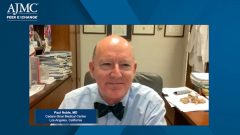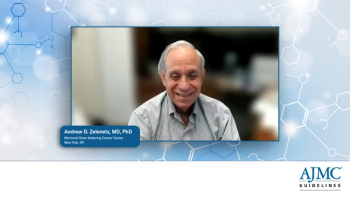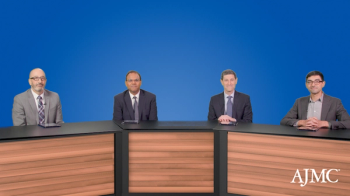
IPF, PF-ILD Treatment Landscape
The panel provides an overview of the treatment landscape for idiopathic pulmonary fibrosis (IPF) and progressing fibrosing ILD (PF-ILD).
Episodes in this series

Ryan Haumschild, PharmD, MS, MBA: I do want to dive deeper into the overview of treatment landscape for idiopathic pulmonary fibrosis [IPF], and then we’ll move on to progressive fibrosing ILD [interstitial lung disease] and then lastly, systemic sclerosis. Dr Culver, you were hitting on it before, but when we think about idiopathic pulmonary fibrosis, can you talk us through what are the treatments for [that disease]? What is some of that efficacy that you’re considering when you’re deciding for patients, and what are the FDA-approved treatment options for those patients?
Daniel Culver, DO: Sure, thank you. Idiopathic pulmonary fibrosis is generally inexorable. It is only somewhat predictable, and so when we diagnose somebody with idiopathic pulmonary fibrosis, the first part of it is a discussion with the patient about, as Paul said, the goals of therapy, what we can expect, and how we can ameliorate that. We’re really looking at improving survival, preventing patients from death or lung transplant, but also maintaining functional capacity and quality of life. Those are very important goals that are often aligned, but sometimes not. Untangling those pieces with the patient is a really important part of a patient-centered discussion. As we think about the treatment of idiopathic pulmonary fibrosis, assuming that we have the right diagnosis and we’re not dealing with occult HP [hypersensitivity pneumonitis] or something else, I focus on issues around comorbid diseases or considerations that can help accelerate the disease. Some of those include things like gastroesophageal reflux, exposures to dusts and tobacco, for example. Sleep apnea is very common, and that has some ramifications on patients with IPF and there are some others. Comorbid disease is important, and also the management of the fibrotic process.
As you mentioned, there are 2 FDA-approved medications that both attenuate the decline in the lung function. Very roughly, and this is extremely rough, we can get into the nuances, but they both attenuate the decline on average by about 50%, and the effect size is probably roughly similar. This is just looking at the forced vital capacity [FVC], which is probably still considered the single best surrogate end point. It’s controversial, there’s plenty of debate about the benefits of the FVC, but I think if you’re going to put your money down on 1 thing, the FVC right now is still the single marker that we use as a surrogate end point for clinical trials. When we’re managing patients, we look at much more than the FVC. We look at things like the 6-minute walk, or the level of desaturation as Paul mentioned, the functional capacity, how short of breath are people, gas transfer, measured by things like the diffusing capacity. In some centers, there’s serial imaging that’s looked at. All of these are markers that we look at after we start the antifibrotic [treatment], or in somebody who we’re monitoring without antifibrotics in order to determine whether we’re achieving our goals.
Generally, when a patient’s diagnosed with IPF, I have a discussion with them about the antifibrotics. My personal philosophy is why give up any territory? I don’t think it makes a lot of sense to me, if I have a clear-cut diagnosis of IPF and the patient’s feeling aggressive like that, I don’t know that there’s a good reason to wait. In fact, there are some data suggesting that these drugs are just as effective for patients with mild or early disease. Then we have a discussion about the 2 agents, and frankly, a lot of it comes down to patients’ aversion or appetite for the various side adverse profiles and some of the comorbidities the patient has. I don’t think that today we can say convincingly that 1 of the 2 agents is head and shoulders ahead of the other in terms of efficacy.
Ryan Haumschild, PharmD, MS, MBA: That’s a great background. Before we transition back to Dr Noble, one more question for you, Dr Culver, are there any other agents that you utilize for a lot of these pulmonary patients? How about for pulmonary hypertension [PH]? Are there any unique treatments we want to consider in that area as well for these patients?
Daniel Culver, DO: Pulmonary hypertension is a really important and common sequela of pulmonary fibrosis. It can happen on different mechanisms according to the underlying interstitial lung disease. Some of it is just obliteration of the vascular bed. There’s some emerging biology suggesting there are relationships between the endothelium and the fibrotic process. Then of course, some of the interstitial lung diseases have a primary vasculopathy. I think it’s like bringing coals to Newcastle to speak about this in front of Dr Highland. I think I’m going to defer to her for more nuances, but I will say that there probably is a place for some patients with IPF, and certainly for patients with some of the other interstitial lung diseases, for co-management with pulmonary vasodilators and other agents that target the vasculature.
Kristin Highland, MD: We only have 1 FDA-approved therapy for pulmonary hypertension in the setting of interstitial lung disease, and that’s inhaled treprostinil. Treating pulmonary hypertension in the setting of ILD requires a significant degree of expertise. Using other agents can potentially worsen V/Q [ventilation/perfusion] matching and make patients worse and more hypoxemic. Some of our drugs that we use for pulmonary arterial hypertension, some of those drug studies actually were negative or terminated early for adverse events. So treating pulmonary hypertension in the setting of interstitial lung disease needs to be done very carefully. We do have our first bit of hope with improvement in 6-minute walk test in patients with interstitial lung disease and pulmonary hypertension. In addition, in the INCREASE study, that also showed that NT-proBNP [N-terminal pro-B-type natriuretic peptide] improved, which is a marker of ventricular dysfunction, and there was decreased time to clinical worsening. Interestingly, there seemed to be some improvement in forced vital capacity, which goes along with what Dr Culver said, that there is a connection between our vasculature and fibrotic processes. So it is important that we think about pulmonary hypertension in patients with interstitial lung disease. We know that patients with PH and ILD have increased risk of acute exacerbations, and significantly worse mortality than just having ILD alone, and we have access to being able to use inhaled treprostinil in this group of patients.
Ryan Haumschild, PharmD, MS, MBA: I like that bit of hope. What you reminded me of is why it is so complex managing these patients, and why a pulmonologist really does need to be brought in, especially when we’re using combination treatment. I want to circle back to you, Dr Highland, because I want to reach out to you a little more about some of these questions around systemic sclerosis. But before we get there, Dr Noble, I would like to hear from you. When we’re speaking about progressive fibrosing interstitial lung disease, we heard from Dr Culver comparing and contrasting with IPF, but I’m curious for you for progressing [ILD], what are some of the therapies you go to for treatment? How do they compare against each other in terms of efficacy and safety, and what is your preference in terms of first-line or second-line treatment in the patient population with progressing fibrosis interstitial lung disease?
Paul Noble, MD: The only FDA-approved therapy is nintedanib in that circumstance. The study that led to that approval was very interesting. It sort of reflects our clinical practice in a sense. When you looked at the patients who were enrolled, they all had evidence of disease progression, either by lung function, or imaging, or both. It was really a breakdown of what we’ve been talking about in terms of the differential diagnosis. Once you’ve started to progress, I like to use the analogy that chronic HP, a third of the patients, or rheumatoid arthritis, they can behave clinically like IPF, meaning it’s this inexorable progression despite immunosuppressive therapy. Typically in those circumstances, we would move toward nintedanib in that scenario. Whether to stop the underlying immunosuppression is a case-by-case point. The one piece of data that I liked was actually from the scleroderma study. When you looked at the subset of patients who were on mycophenolate and nintedanib, their loss of lung function was less than patients who were on nintedanib alone, suggesting that idea of still targeting the underlying disease process with some type of immunosuppression with an antifibrotic onboard is reasonable.
The one thing though that I will be honest and say I was disappointed in, despite being a real advocate a decade ago for forced vital capacity as the primary end point, I was disappointed that there was a large FVC difference in the progressive fibrotic trial between placebo and patients on nintedanib, and yet there was really no evidence any other end points were impacted, like quality of life. It really gave me some pause. Is losing less really enough? I must admit, recently I’ve become a little more concerned that this bar of just showing a P-value of an FVC difference when everybody’s getting worse, is that kind of rearranging the deck chairs? I don’t want to get ahead of myself, but my patients still die from IPF or get a lung transplant; 10 years ago they died from IPF or got a lung transplant. Without an improvement in FVC, I’m really beginning to wonder, particularly because the next wave is all about trying to find a drug that has a similar benefit in terms of losing less, but is better tolerated. To me, we need a higher bar, a higher aspiration. If you look at cystic fibrosis [CF], those FEV1 [forced expiratory volume in 1 second] changes weren’t huge, but they were in a positive direction. From what I understand, I don’t do CF, but my colleagues around the country have said that the number of lung transplants for CF has dropped dramatically. That’s really what our goal needs to be. While I do believe that these therapies are an advance, I think we can’t lose sight of the goal of still trying to see if we can get people better.
Daniel Culver, DO: I agree with you, we need to do better. I look at this as a bit analogous to pulmonary vascular disease 15 years ago, and when we talked about you’re just shifting the time to the 6-minute walk deterioration and big deal, what are you doing? We clearly have a long way to go. As you mentioned, the decline in FVC doesn’t go to 0 with these drugs, it just slows. That’s an average; there are plenty of patients who don’t even seem to pay attention to being on the drug. They just keep going. I do think that I see more patients who have what I call boring visits, where we get to talk about their grandchildren’s Little League game instead of their problems because they’re just about the same as they were. I think some of the registry data suggest there may be some shifts in the natural history a little, but a long way to go, as you said. I think the point you made about non-IPF ILD is really important. Even though you decrease the decline of FVC on average, in general, those diseases tend to progress less aggressively than IPF. You’re hitting a, I wouldn’t call it a ceiling effect, but your opportunity for improvement is not quite the same, and so reducing the change in FVC by a few dozen milliliters a year, I also wonder, what are you really accomplishing with that?
This transcript has been edited for clarity.
Newsletter
Stay ahead of policy, cost, and value—subscribe to AJMC for expert insights at the intersection of clinical care and health economics.














































